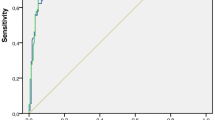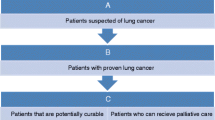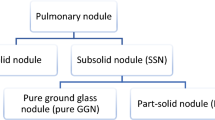Abstract
Purpose
Diagnosis of solitary pulmonary nodule (SPN) is an important public health issue and 18F-FDG PET/CT has proven to be more effective than CT alone. Pre-test risk stratification and clinical presentation of SPN could affect the diagnostic strategy. A relevant issue is whether thoracic segmental (s)-PET/CT could be implemented in patients with SPN. This retrospective multicenter study compared the results of FDG whole-body (wb)-PET/CT to those of s-PET/CT.
Methods
18F-FDG PET/CT of 502 patients, stratified for pre-test cancer risk, were retrospectively analyzed. The thoracic part of wb-PET/CT, considered s-PET/CT, was compared to wb-PET/CT. Clinical and PET/CT variables were investigated for SPN characterization as well as for identification of patients in whom s-PET/CT could be performed. Histopathology or follow-up data were used as a reference.
Results
In the study population, 36% had malignant, 35% benign, and 29% indeterminate SPN. 18F-FDG uptake indicative of thoracic and extra-thoracic lesions was detectable in 13% and 3% of the patients. All patients with extra-thoracic metastases (n = 13) had thoracic lymph node involvement and highest 18F-FDG uptake at level of SPN (negative predictive value 100%). Compared to wb-PET/CT, s-PET/CT could save about 2/3 of 18F-FDG dose, radiation exposure or scan-time, without affecting the clinical impact of PET/CT.
Conclusion
Pre-test probability of malignancy can guide the diagnostic strategy of 18FDG-PET/CT in patients with SPN. In subjects with low-intermediate pretest probability s-PET/CT imaging might be planned in advance, while in those at high risk and with thoracic lymph node involvement a wb-PET/CT is necessary.
Similar content being viewed by others
References
Callister ME, Baldwin DR, Akram AR, Barnard S, Cane P, Draffan J, et al. British Thoracic Society pulmonary nodule guideline development group; British Thoracic Society standards of care committee. British Thoracic Society guidelines for the investigation and management of pulmonary nodules. Thorax. 2015;70(Suppl 2):ii1–ii54.
Goldstraw P, Crowley JJ. The International Association for the Study of Lung Cancer international staging project on lung cancer. J Thorac Oncol. 2006;1:281–6.
Sim YT, Poon FW. Imaging of solitary pulmonary nodule-a clinical review. Quant Imaging Med Surg. 2013;3:316–26.
Huang B, Law MWM, Khong PL. Whole-body PET/CT scanning: estimation of radiation dose and cancer risk. Radiology. 2009;251:166–74.
Brix G, Lechel U, Glatting G, Ziegler SI, Münzing W, Müller SP, et al. Radiation exposure of patients undergoing whole-body dual-modality 18F-FDG PET/CT examinations. J Nucl Med. 2005;46:608–13.
Yi CA, Lee KS, Kim BT, Choi JY, Kwon OJ, Kim H, et al. Tissue characterization of solitary pulmonary nodule: comparative study between helical dynamic CT and integrated PET/CT. J Nucl Med. 2006;47:443–50.
Al-Ameri A, Malhotra P, Thygesen H, Plant PK, Vaidyanathan S, Karthik S, et al. Risk of malignancy in pulmonary nodules: a validation study of four prediction models. Lung Cancer. 2015;89:27–30.
Gould MK, Donington J, Lynch WR, Mazzone PJ, Midthun DE, Naidich DP, et al. Evaluation of individuals with pulmonary nodules: when is it lung cancer? Diagnosis and management of lung cancer, 3rd ed: American College of Chest Physicians Evidence-Based Clinical Practice Guidelines. Chest. 2013;143(5 Suppl):e93S–e120S.
MacMahon H, Austin JH, Gamsu G, Herold CJ, Jett JR, Naidich DP, et al. Guidelines for management of small pulmonary nodules detected on CT scans: a statement from the Fleischner society. Radiology. 2005;237:395–400.
National Lung Screening Trial Research Team, Aberle DR, Adams AM, Berg CD, Black WC, Clapp JD, et al. Reduced lung-cancer mortality with low-dose computed tomographic screening. N Engl J Med. 2011;365:395–409.
Tasdemir B, Urakci Z, Dostbil Z, Unal K, Simsek FS, Teke F, et al. Effectiveness of the addition of the brain region to the FDG-PET/CT imaging area in patients with suspected or diagnosed lung cancer. Radiol Med. 2016;121:218–24.
Sullivan R, Peppercorn J, Sikora K, Zalcberg J, Meropol NJ, Amir E, et al. Delivering affordable cancer care in high-income countries. Lancet Oncol. 2011;12:933–80.
Einstein AJ. Effects of radiation exposure from cardiac imaging. How good are the data? J Am Coll Cardiol. 2012;59:553–65.
International Commission on Radiological Protection (ICRP) Strategic Plan for 2016–2020. http://www.icrp.org/docs/ICRP%20Strategic%20Plan%202016-2020.pdf. Accessed March 1, 2017.
Boellaard R, Delgado-Bolton R, Oyen WJG, Giammarile F, Tatsch K, Eschner W, et al. FDG PET/CT: EANM procedure guidelines for tumor imaging: version 2.0. Eur J Nucl Med Mol Imaging. 2015;42:328–54.
Delbeke D, Coleman RE, Guiberteau MJ, Brown ML, Royal HD, Siegel BA, et al. Procedure guideline for tumor imaging with 18F-FDG PET/CT 1.0. J Nucl Med. 2006;47:885–95.
Spadafora M, Pace L, Mansi L. Segmental 18F-FDG-PET/CT in a single pulmonary nodule: a better cost/effectiveness strategy. Eur J Nucl Med Mol Imaging. 2017;44:1–4.
Spadafora M, Evangelista L, Gridelli C, Cuocolo A. Alternative imaging strategy of solitary pulmonary nodule by FDG PET/CT: can be imagined a tailored PET? Eur J Radiol. 2017;90:188–91.
Spadafora M, Pace L, Mansi L. The delicate balance between present and future. Eur J Nucl Med Mol Imaging. 2017;44:346–7.
Hustinx R. How to scan who: the delicate balance between selecting the patient and selecting the imaging protocol. Eur J Nucl Med Mol Imaging. 2017;44:5–7.
Evangelista L, Spadafora M, Pace L, Mansi L, Cuocolo A. Italian tailored assessment of lung indeterminate accidental nodule by proposing a segmental PET/computed tomography (s-PET/CT): Rationale and study design of a retrospective, multicenter trial. Curr Radiopharm 2018;11(1):46–49.
McWilliams A, Tammemagi MC, Mayo JR, Roberts H, Liu G, Soghrati K, et al. Probability of cancer in pulmonary nodules detected on first screening CT. N Engl J Med. 2013;369:910–9.
ICRP. The 2007 Recommendations of the International Commission on Radiological Protection. ICRP publication 103. Ann ICRP. 2007;37:1–332.
Horeweg N, van Rosmalen J, Heuvelmans MA, van der Aalst CM, Vliegenthart R, Scholten ET, et al. Lung cancer probability in patients with CT-detected pulmonary nodules: a prespecified analysis of data from the NELSON trial of low-dose CT screening. Lancet Oncol. 2014;15:1332–41.
Kagna O, Solomonov A, Keidar Z, Bar-Shalom R, Fruchter O, Yigla M, et al. The value of FDG-PET/CT in assessing single pulmonary nodules in patients at high risk of lung cancer. J Nucl Med Mol Imaging. 2009;36:997–1004.
Goldstraw P, Crowley J, Chansky K, Giroux DJ, Groome PA, Rami-Porta R, et al. International Association for the Study of Lung Cancer International Staging Committee. The IASLC Lung Cancer staging project: proposals for the revision of the TNM stage groupings in the forthcoming (seventh) edition of the TNM classification of malignant tumours. J Thorac Oncol. 2007;2:706–14.
Iskandrian AE, Dilsizian V, Garcia EV, Beanlands RS, Cerqueira M, Soman P, et al. Myocardial perfusion imaging: lessons learned and work to be done-update. J Nucl Cardiol. 2018;25:39–52.
Siegel JA, Pennington CW, Sacks B. Subjecting radiologic imaging to the linear no-threshold hypothesis: a non sequitur of non-trivial proportion. J Nucl Med. 2017;58:1–6.
Iglehart JK. Health insurers and medical-imaging policy: a work in progress. N Engl J Med. 2009;360:1030–7.
Patz EF Jr, Pinsky P, Gatsonis C, Sicks JD, Kramer BS, Tammemägi MC, et al. Over-diagnosis manuscript writing team over-diagnosis in low-dose computed tomography screening for lung cancer. JAMA Intern Med. 2014;174:269–74.
Acknowledgements
We thank Christina A. Drace, Istituto Oncologico Veneto-IRCCS, Padova, Italia, for assistance in writing this manuscript.
Author information
Authors and Affiliations
Corresponding author
Ethics declarations
Conflict of interest
None.
Ethical approval
All procedures performed in studies involving human participants were in accordance with the ethical standards of the institutional research committee and with the 1964 Helsinki declaration and its later amendments or comparable ethical standards.
Informed consent
Informed consent was obtained from all individual participants included in the study.
Additional information
Italian Tailored Assessment of Lung Indeterminate Accidental Nodule
Rights and permissions
About this article
Cite this article
Spadafora, M., Pace, L., Evangelista, L. et al. Risk-related 18F-FDG PET/CT and new diagnostic strategies in patients with solitary pulmonary nodule: the ITALIAN multicenter trial. Eur J Nucl Med Mol Imaging 45, 1908–1914 (2018). https://doi.org/10.1007/s00259-018-4043-y
Received:
Accepted:
Published:
Issue Date:
DOI: https://doi.org/10.1007/s00259-018-4043-y




